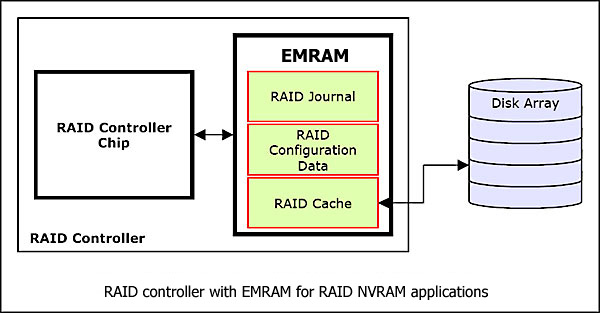|
|
EMRAM (Magneto-resistive Random Access Memory) is nonvolatile, has the speed of SRAM (40ns-70ns), and has unlimited write endurance. This document outlines how EMRAM can be a higher performance, lower cost replacement to existing NVRAM technologies in RAID controllers. | ||||
|
RAID |
|||||
|
EMRAM for RAID Controllers
RAID (Redundant Arrays of Independent Disk Drives) systems are built for EDAP (Extended Data Availability and Protection). In today’s demand for high data availability and reliability, RAID system must ensure data integrity and provide immediate access to stored data after the rectification of any system failure. Most modern RAID systems thus store key data such as restart vectors in a nonvolatile memory on the controller board. All this is managed by the Array Management Software, which runs either in the host or on the controller. Embedded controllers that offer high data reliability and increased I/O performance in one package have become the standard on RAID. High performance embedded processors, latest software and control algorithms can be found on the RAID controller. RAID Controller Memory Requirements The array management software is constantly moving data among the array members, and there are three primary applications that benefit from EMRAM. RAID Journal Immediate data recovery upon power restoration is required, and the restart vectors can be stored in an appropriate nonvolatile memory on the controller board itself. The RAID controller is constantly moving data among the individual array members to optimize I/O balance, maximize I/O rates, and assure redundancy; hence the address vector tables are constantly being updated. Unlimited write endurance is required, and EMRAM, with its unlimited write endurance, is ideal for RAID journal. RAID Configuration Data RAID Caches Adding battery-backed SRAM is an expensive and cumbersome way of solving this problem. Periodic board maintenance is required to ensure proper functioning of batteries. EMRAM is ideal for those critical caches where the maintenance, record keeping and expenses of battery-backup solutions are to be avoided.
Parallel EMRAM is ideal for RAID controller application:
© 2004 Northern Lights Semiconductor Corp – All Rights Reserved |
|||||

